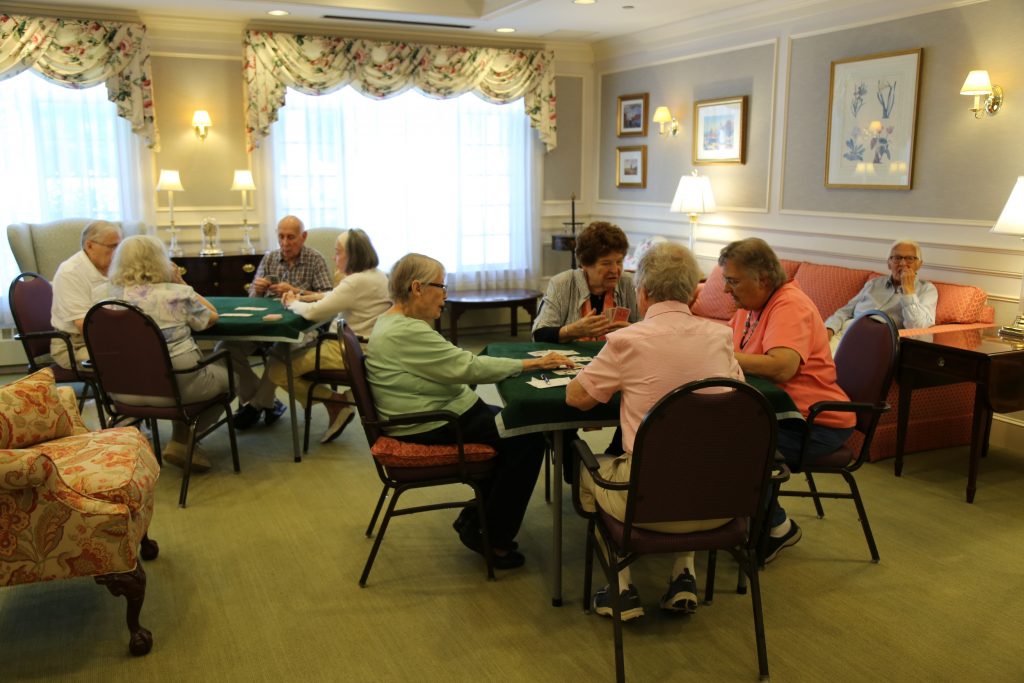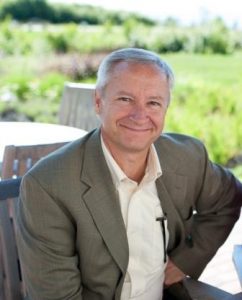Join us at The Atrium for a Presentation with
Historian Jerry Wiles on Maya Angelou
Thursday July 17
FMI please call 207-221-7100
Join us at The Atrium for a Presentation with
Historian Jerry Wiles on Maya Angelou
Thursday July 17
FMI please call 207-221-7100
Join us at The Atrium at The Cedars on June 25 for a concert with
Michael Beling and Saxophonist Bill Street
For more information or to RSVP, call 207-221-7100
 What do you do when you hear about someone in need? At The Osher Inn, assisted living at The Cedars, a group of more than six residents dusted off their knitting needles and joined forces to help. A few months ago, a few residents at The Osher Inn heard of a man receiving services from VNA Hospice – who just couldn’t stay warm. They didn’t miss a beat and gathered their friends at The Osher Inn to create a blanket as a donation to hospice.
What do you do when you hear about someone in need? At The Osher Inn, assisted living at The Cedars, a group of more than six residents dusted off their knitting needles and joined forces to help. A few months ago, a few residents at The Osher Inn heard of a man receiving services from VNA Hospice – who just couldn’t stay warm. They didn’t miss a beat and gathered their friends at The Osher Inn to create a blanket as a donation to hospice.
“It took around three months, with more than six of us working on it”, the group explained. None of the knitters had picked up needles in years, but they jumped back in willingly. “Fingers change over the years,” one knitter explained, “the needles are slippery and they didn’t used to be!” Another resident, who owned a yarn store in Portland for many years, says that using wooden needles makes it easier. The result of their work is a beautiful blanket full of color that can be washed and dried at home.
Now that they’ve made their donation, the group looks forward to finding another project. “It gets easier, the more you do it,” said another resident. In the meanwhile, these many hands have provided a hospice patient with a much needed warm embrace.
Join us Thursday June 12 from 2-4PM for our
Almost-Summer Open House at The Atrium
Find out all that Independent Living has to offer
Meet our Members and Enjoy Refreshments in our Courtyard
RSVP 207-221-7100
 The Cedars is pleased to welcome Nancy Kuliga back to The Cedars as the Wellness Manager at The Osher Inn, assisted living at The Cedars. Nancy is no stranger to our community as she was the Director of Nursing for several years at our Skilled Care Center at The Cedars.
The Cedars is pleased to welcome Nancy Kuliga back to The Cedars as the Wellness Manager at The Osher Inn, assisted living at The Cedars. Nancy is no stranger to our community as she was the Director of Nursing for several years at our Skilled Care Center at The Cedars.
Nancy has a multitude of experiences in senior care: she has served the Director of Resident Services at an area assisted living specializing in dementia care, acted as a Professional Services Consultant/ Director of Clinical Services for North Country Associates and Manager of Clinical Operations for Genesis Health Care.
Nancy has worn many different hats throughout her nursing career and possesses strong skills with nursing leadership, management, knowledge of regulations governing assisted living and extensive knowledge of best clinical practices. Additionally she possesses certifications in nursing leadership, dementia care, and the minimum data set, which is the tool that determines long term care compensation levels.
Nancy is enthused about this new chapter in her life. “I am very, very excited about being here – working with the team and doing the best for our residents.” She continues, “I am a people-person and I look forward to getting to know each resident and their families – the sooner the better!” Please join us in welcoming Nancy to The Osher Inn.

When Les Brewer first moved to The Atrium at The Cedars in the spring of 2013, he was pleased to hear that there was a standing bridge game every Thursday evening. At the time, there were a few tables of avid bridge players who would routinely meet. Over the course of the year, Les has taken on the role of coordinating the game and opening the fun to new players and novices alike. “Everyone enjoys the hour and a half on Thursday nights – it keeps the mind occupied and it’s very social,” Les explains.
When Les was growing up he would watch his grandparents play bridge, learning the game through observation. Whenever there was an opportunity to play, he would join them. In college, bridge was a popular early-evening activity in his Beta Theta Pi fraternity house at the University of Maine. Then, while stationed in Paris, France during WWII, he would walk to the Red Cross building where there was a bridge game almost every night. “It kept many of us sane,” Les explains. Once married, his busy family life allowed him to play only occasionally with friends. Sixty-five years later, Les is back in the game.
Last spring, Les invited anyone interested in bridge to join – starting with a discussion of general guidelines that incorporate the four parts: bidding, playing, scoring, and etiquette. Soon interest increased and today there is a consistent group of 18. “If they haven’t played, we’ll teach them to play in whatever method works for them.”
And there’s always room for more. “If I hear of someone who has played bridge in the past, I’ll invite them to join. Part of running bridge is looking for new players because not everyone is available all the time.” He continues, “If I hadn’t done this, I would have done something else. I enjoy seeing things happen and they will if you manage them.”
For more information on The Cedars Retirement Living, please call our marketing representative at 207-221-7100.
Join us for support and insight with other caregivers
May 21, 2014 from 3-4PM
for more information call 221-7150
The Cedars will Honor our Community of Older Americans
with an Open House and Resident Art Show
Thursday May 1 from 2-4PM
FMI call 207-221-7100
 On March 5, LD 1776: An Act to Implement the Recommendations of the Long Term Care Facilities Study Commission received a public hearing before the Committee on Health and Human Services. John Watson, Chief Financial Officer at The Cedars, was one of the presenters.
On March 5, LD 1776: An Act to Implement the Recommendations of the Long Term Care Facilities Study Commission received a public hearing before the Committee on Health and Human Services. John Watson, Chief Financial Officer at The Cedars, was one of the presenters.
John was a gubernatorial appointee to the Long Term Care Facilities Study Commission that authored LD 1776 and was recognized for his work and leadership. The Committee concluded Maine must rectify years of chronic underfunding to nursing homes. Rural areas are hardest hit and many are in danger of closing, but even urban facilities are challenged to make ends meet.
The Commission urged the legislature to pass $2 million in relief for struggling facilities in rural Maine; a bill to study funding problems in rural Maine facilities; and a bill sponsored by LeadingAge to end the current system of MaineCare reimbursements and would require the state to pay providers the $35-40 million in care costs it fails to reimburse each year.
“We need to stop relying on providers to meet our obligation to rural and low-income elders,” John explains. “Everyone needs access to quality long term care.” On April 16, John was recognized by LeadingAge with an Advocacy Award for his work on this important issue.
 Richard Marino, MD of Maine Medical Partners Geriatrics and Medical Director at The Cedars, was recently named Maine’s best physician for Geriatric Services in Down East Magazine’s TopDocs survey. His exacting and compassionate commitment to senior health was recognized by his peers, and sets The Cedars apart.
Richard Marino, MD of Maine Medical Partners Geriatrics and Medical Director at The Cedars, was recently named Maine’s best physician for Geriatric Services in Down East Magazine’s TopDocs survey. His exacting and compassionate commitment to senior health was recognized by his peers, and sets The Cedars apart.
“We have two main goals for our rehab patients,” Dr. Marino explains. “First, we help them get stronger, so they can return home. Secondly, we prevent re-hospitalizations.”
To avoid having to transfer patients to and from the hospital for tests or treatment, Dr. Marino’s team is at The Cedars five days a week and available 24/7. “We address patient needs as soon as they arise, and anticipate problems before they occur,” he says.
This extraordinary level of state-of-the-art care keeps our re-hospitalization rate at just 9% — less than half of the national average!
For more information on The S.L. Cohen Rehabilitation Center at The Cedars, contact us or call 207-221-7000.